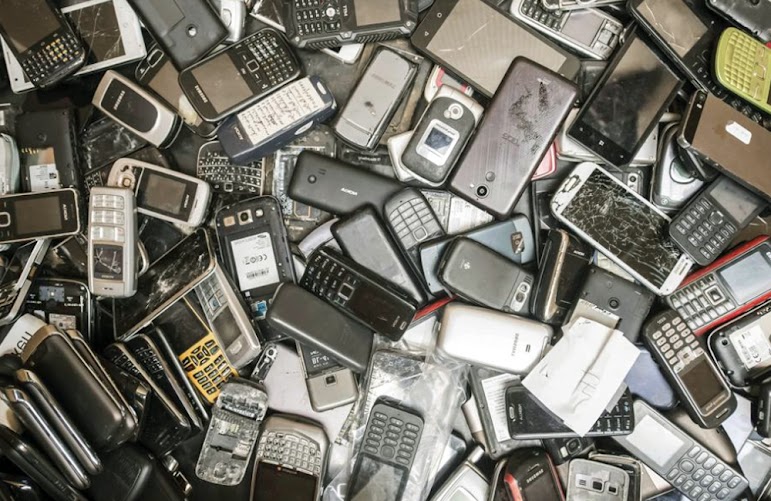 |
| The Montana Mountains tower over Thacker Pass in northern Nevada. Lithium Americas has proposed a new lithium mining project for Thacker Pass, which is nearing completion, on July 14, 2021, The mine in northern Nevada would produce millions of tons of lithium, but Native American groups have said it should be banned since it is located in the holy land. (Image Credit: Jason Bean/The Reno Gazette-Journal) |
AP: In the United States, there is a race to produce more lithium. The United States will require far more lithium to meet its clean energy targets, and the industry that mines, extracts, and processes the chemical element is expected to expand. However, it faces a slew of challenges from environmentalists, Indigenous groups, and government regulators.
Despite the fact that lithium reserves are found all over the world, the United States has only one active lithium mine, which is located in Nevada. The element is critical to the development of rechargeable lithium-ion batteries, which are seen as critical to reducing climate-changing carbon emissions produced by automobiles and other modes of transportation.
In 2020, global demand for lithium was approximately 350,000 tons (317,517 metric tons), but industry estimates predict that demand will be up to six times higher by 2030. In states such as Maine, North Carolina, California, and Nevada, new and potential lithium mining and extraction projects are in various stages of development.
"Nobody could have predicted such a massive increase in demand," said Tim Crowley, vice president of government affairs for Lithium Nevada, a subsidiary of a company developing a mine in Thacker Pass, Nevada. "We owned the lithium space for a long time and gave it up to China."
 |
| In Niland, California, on Thursday, July 15, 2021, a dried-up section of the Salton Sea extends out with a geothermal power plant in the distance. Demand for electric vehicles has sped up investments in geothermal wastewater extraction around the increasingly decreasing body of water. In rechargeable batteries, lightweight metal is essential. (Image Credit : Photographer Marcio Jose Sanchez) |
South America and Australia supply the majority of the world's lithium, and China dominates the global supply chain for lithium-ion batteries. Although it has about 4% of the world's reserves, the United States produces less than 2% of the world's supply of lithium. Chile has the world's largest reserves.
Expansion of domestic lithium production would necessitate open pit mining or brine extraction, which entails pumping mineral-rich brine to the surface and processing it. Opponents, including the Sierra Club, have expressed concern that the projects could endanger sacred Indigenous lands as well as fragile ecosystems and wildlife.
However, according to Glenn Miller, emeritus professor of environmental sciences at the University of Nevada, the projects could benefit the environment in the long run by getting fossil fuel-burning cars off the road.
"A domestic source is extremely valuable. "Then we can do things with production that only China can do," Miller explained.
Johan August Arfwedson, a Swedish chemist, discovered lithium, the lightest metal on Earth, more than 200 years ago. Since then, lithium and its derivatives have been used in a variety of applications ranging from psychiatric medicine to lubricating grease.
However, interest in lithium has skyrocketed in recent years due to its use in rechargeable batteries for electric and hybrid cars, lawnmowers, power tools, and other applications. Laptops and cell phones are also powered by lithium batteries.
 |
| On July 13, 2018, discarded mobile phones fill a dumpster at the Out Of Use company warehouse in Beringen, Belgium. The use of lithium in rechargeable batteries for electric and hybrid cars, lawnmowers, power tools, and other applications has sparked a surge of interest in the past few years. Laptops and cell phones are also powered by lithium batteries. Image Credit: Vanden Wijngaert |
The Biden administration has made a plan for 500,000 electric vehicle charging stations a centerpiece of its infrastructure goals. This effort, as well as the growth of electric vehicle companies such as Tesla, will necessitate the use of significantly more lithium in the production of batteries.
 |
| Nissan, Tesla, and Toyota electric cars are seen at a news conference in Los Angeles on December 13, 2013. In 2020, global lithium demand was over 350,000 tons (317,517 metric tons), but industry projections suggest demand may be up to six times higher by 2030. (Image Credit Nick Ut) |
Lithium Americas' proposed Thacker Pass lithium mining project is the closest to completion. That northern Nevada mine would produce millions of tons of lithium, but Native American tribes have argued that it is on sacred land and should be interrupted.
Renovation could begin late this year, according to Lithium Americas CEO Jonathan Evans, who noted that it would be the first lithium project permitted on federal land in six decades.
Because of rising demand, Evans predicts that there will be more attempts to extract lithium in the United States. "It was a small industry that grew quickly," he said. "I do anticipate larger companies entering the space through acquisitions or other means."
Ioneer, based in Australia, also intends to build a large lithium mine in Nevada, which the company claims will produce 22,000 tons (19,958 metric tons) of lithium per year, enough to power hundreds of thousands of electric vehicles.
 |
| A Tesla battery pack is shown during a media tour of Tesla Motors Inc.'s new Gigafactory on Tuesday, July 26, 2016, in Sparks, Nevada. Because of its use in rechargeable batteries for electric and hybrid cars, lawnmowers, power tools, and other items, interest in lithium has skyrocketed in recent years. Laptops and cell phones are also powered by lithium batteries. (Image Credit: Rich Pedroncelli) |
Environmentalists face a challenge when it comes to lithium mining projects because they offer the promise of decarbonization in exchange for significant impacts on ecosystems and local communities. According to the Sierra Club, lithium mining could jeopardize water quality and ranching in some states.
According to Lisa Belenky, senior attorney for the Center for Biological Diversity, the main challenge is ensuring that lithium mines are located in areas where they cause the least amount of damage.
"It's really site-specific in terms of what impacts it would have on local species and water," Belenky said. "Mostly every energy project we consider for climate change mitigation has its own greenhouse gas footprint."
The desire for more domestic lithium has created opportunities for mining and extraction in states other than Nevada. Piedmont Lithium, an Australian company, wants to develop an open-pit mining project in the Kings Mountain area west of Charlotte, North Carolina. According to the company, the area was a major supplier of lithium from the mid-twentieth century until the 1980s.
The salty and diminishing Salton Sea, California's largest lake, is also a strong choice for lithium mining. Geothermal brine can be used to collect lithium, and geothermal plants have been pumping brine into the Salton Sea for decades. Lithium extraction from the lake, according to proponents, would use less land and water than other bringing methods.
 |
| Friday, July 16, 2021: Derek Benson, CEO of EnergySource Minerals, walks through the Featherstone plant in Calipatria, Calif., where the firm produces geothermal energy and extracts lithium from brine. EnergySource Minerals has been extracting lithium there on a modest scale since 2016, according to Benson, and the business aims to create a much larger addition for mineral extraction in the future. (Photo Credit: Marcio Jose Sanchez) |
California's lithium can help the state become a leader in battery manufacturing, according to Democrat Gov. Gavin Newsom. During a January speech, he referred to the state as the "Saudi Arabia of lithium."
Lithium is becoming an "increasingly vital resource," according to Dee Dee Myers, a senior advisor to Newsom who focuses on business, as California and the rest of the world pursue sustainable energy development to mitigate and adapt to climate change.
Given the resources near the Salton Sea, the state has the potential to create "epic quantities of lithium," according to Myers. However, she stated that the company wants to ensure that lithium is harvested and produced in a sustainable manner.
 |
| On Monday, July 26, 2010, an evaporation pond used to analyze lithium and other minerals levels lie in the Uyuni salt desert near Colchani, Bolivia. Because of its lithium riches, the salt flats of Uyuni have piqued the interest of multinational energy companies, and Bolivia expects that the metal will power a green revolution when electric cars reach widespread production. (Image Credit: Dado Galdieri ) |
The state government could be able to help regulate the extraction process. California also established the Lithium Valley Commission in 2020 to study and analyze lithium production incentives. By October, they must submit a report detailing their findings.
Plumbago Mountain, located in the western region of Maine, has sparked mining interest. According to research published in the scientific journal Mineralium Deposita in 2020, the mountain is "a potentially important new lithium resource" with a greater average lithium content than similar deposits throughout the world.  |
| In this photo made on Feb. 10, 2020, in Reno, Nevada, Beth Leger, a plant ecologist at the University of Nevada, Reno, gestures to a little Tiehm's buckwheat that has sprouted at a campus greenhouse. An Australian mining corporation is funding its research because it intends to extract lithium in the high desert 200 miles southeast of Reno, the world's only known location for the uncommon wildflower. UNR researchers are investigating whether the plant or seeds developing in the greenhouse can be transplanted to the desert to help the native population. (Image Credit: Scott Sonner) |
Maine mining restrictions, on the other hand, may make it difficult to collect lithium. According to state mining coordinator Mike Clark, the Maine Department of Environmental Protection is looking into the prospect of quarrying for lithium at Plumbago at the request of the property's owners.
According to Alicia Cruz-Uribe, an associate professor of petrology and mineralogy at the University of Maine, Plumbago Mountain is the type of location that might be crucial for the United States as it strives to meet its clean energy goals.
Cruz-Uribe again stated, the country's lithium reserves are among the world's largest. "However, the amount we produce is insignificant."
---------------------------------------------------------------------------------------------------------------------------
Source: Kathleen Ronayne of the Associated Press contributed to this story from Sacramento, California. Several private foundations sponsor the Associated Press' climate and environmental reporting. More info about the AP's climate project can be found here. All content is entirely the responsibility of the AP.

















0 Comments
please do not enter any spam link in the comment box